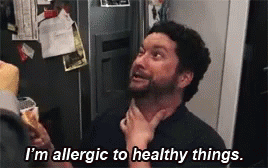🍓 Why Are Kids Allergic to Everything Now? A Deep Dive into Childhood Food Allergies

Natural Sciences | The Varrock Street Journal
What is happening this Wednesday, readers!
Have you ever wondered why it feels like nearly every classroom now has a peanut-free table or why daycare forms include detailed allergy checklists? Childhood food allergies have skyrocketed in recent years, turning everyday snacks into potential medical emergencies.
In today’s newsletter, we’re diving into the science of food allergies in children—what they are, why they’re becoming more common, how they’re diagnosed, and what new research says about managing and possibly preventing them.

🌾 What Is a Food Allergy?
A food allergy is an immune system overreaction to proteins in certain foods. Unlike a food intolerance (which is non-immune and often related to digestion), food allergies involve IgE antibodies, which trigger the release of chemicals like histamine, causing symptoms that range from hives and swelling to vomiting and even anaphylaxis, a potentially life-threatening reaction.
Common allergens include:
🥜 Peanuts | 🌰 Tree nuts | 🥛 Milk | 🥚 Eggs | 🌾 Wheat | 🐟 Fish | 🦐 Shellfish | 🌱 Soy | 🌻 Sesame
📈 Why Are Food Allergies on the Rise?
The global prevalence of childhood food allergies is estimated to be around 4–8%, and it’s increasing—especially in industrialized countries. Several reasons are contributing to this trend:
- Delayed exposure to allergens in infancy
- Changes in gut microbiota (thanks to antibiotics, diet, or C-sections)
- Over-sanitized environments (the hygiene hypothesis)
- Genetic predisposition, especially in families with other allergic diseases like asthma or eczema
Interestingly, some ethnic and racial groups experience higher rates and more severe reactions, likely due to both genetics and environmental factors.
🧪 How Are Food Allergies Diagnosed?
Diagnosing a food allergy can be tricky. Here are the tools clinicians use:
- Skin Prick Testing (SPT): A drop of allergen is scratched into the skin to see if a reaction occurs.
- Serum IgE Testing: Blood tests that detect allergen-specific antibodies.
- Component Resolved Diagnostics (CRD): Identifies specific protein components responsible for triggering reactions.
- Oral Food Challenge (OFC): The gold standard—supervised eating of the suspected allergen in increasing doses.
Each of these has its limitations, and results are most reliable when interpreted alongside a detailed clinical history.

🚨 What Happens During an Allergic Reaction?
Reactions can range from mild to severe and involve multiple body systems:
- Skin: Hives, itching, swelling
- Respiratory: Wheezing, coughing, difficulty breathing
- GI: Vomiting, abdominal pain, diarrhea
- Cardiovascular: Dizziness, low blood pressure, collapse
The most serious form, anaphylaxis, can occur rapidly and requires immediate treatment with an epinephrine autoinjector, also known as an EpiPen!
💊 Is There a Cure?
Right now, there is no permanent cure for food allergies. The mainstay of treatment remains strict avoidance and having an emergency action plan.
But science is advancing:
- Oral Immunotherapy (OIT): Introducing small, increasing doses of an allergen to build tolerance.
- Palforzia: An FDA-approved therapy for peanut allergy.
- Biologics (like omalizumab): Targeted treatments that may make OIT safer.
- Probiotics: Early evidence suggests they might help train the immune system in infants.
🍼 Prevention: Early Introduction Is Key
Forget the old advice to avoid allergens in infancy. The LEAP Study (Learning Early About Peanut) found that introducing peanuts early and often (before 12 months of age) significantly reduces the risk of allergy.
Countries like Canada and the UK have updated their guidelines to reflect this. For most infants, early exposure to foods like peanut, egg, and milk may be protective, not harmful.
👪 Why This Matters
Food allergies don’t just affect meals—they shape a child’s entire social and emotional world. From birthday parties to school lunches, these children and their families must be constantly vigilant. The psychological toll is real—parents report high levels of anxiety and stress, especially after witnessing a severe reaction.
Improving diagnosis, treatment, and education around food allergies could make a huge impact on quality of life for millions of families worldwide.
🧠 Spotlight on the Future
🔬 New diagnostic tests, like the Basophil Activation Test (BAT), promise better accuracy in identifying real allergies versus simple sensitization.
💉 Safer immunotherapy protocols are in development to desensitize children with fewer risks.
🌱 Microbiome research may unlock preventive strategies in infancy.
The goal? A future where food allergies can be accurately diagnosed, safely treated, and possibly prevented altogether.
😲 Did You Know?
- Up to 1 in 13 U.S. children have a food allergy.
- Milk and egg allergies are often outgrown—many by age 5.
- Sesame has recently become the 9th most common allergen in the U.S., now requiring labeling on food products.
🧠 Reflection Questions
- How can schools and communities better support children with food allergies?
- Should food allergy screening become a routine part of pediatric care?
- What are the ethical considerations in starting oral immunotherapy in very young children?
👋 Final Thoughts
Food allergies are more than a passing phase—they’re a global health challenge. But with continued research, smarter prevention strategies, and compassionate care, we’re getting closer to turning the tide.
📚 References:
Elghoudi, A., & Narchi, H. (2022). Food allergy in children—the current status and the way forward. World Journal of Clinical Pediatrics, 11(3), 253–269. https://doi.org/10.5409/wjcp.v11.i3.253
Institute for Quality and Efficiency in Health Care (IQWiG). (2019, September 5). What kinds of allergy tests are there? InformedHealth.org. https://www.informedhealth.org/what-kinds-of-allergy-tests-are-there.html
National Institute of Allergy and Infectious Diseases (NIAID). (2017). Addendum guidelines for the prevention of peanut allergy in the United States. https://www.niaid.nih.gov/diseases-conditions/guidelines-clinicians-and-patients-food-allergy
📲 Stay connected and keep learning:
- Instagram: @thevarrockstreetjournal
- TikTok: @varrock.street.jo
